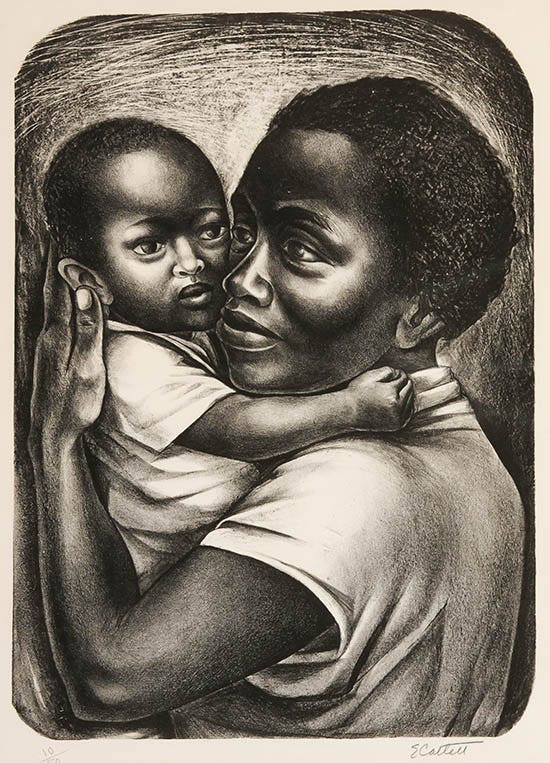Your Favorite Representations of Women
In literature and visual art, the portraits of women that ring true
Before Thanksgiving, I asked you for your examples of artists who depict women well (sparked in part by a polarizing tribute to Mary Wollstonecraft). I expected mostly examples of visual art, but you listed a number of novels, too. Next week, I look forward to sharing your recommendations of charities that take interdependence seriously.
I’ve also done an interview with Gracy Olmstead at Mere Orthodoxy about alternative feminisms and what I hope to do with this newsletter. You can read it here.

Martha introduced me to the work of Elizabeth Catlett, whose “Black Maternity” is pictured above. Catlett was an African-American artist, whose scholarship to the Carnegie Institute of Technology in Pittsburgh was rescinded because she was Black. She drew from Cubist, Primitivist, and Mexican muralist influences in her work.
Colleen recommended George Eliot (Marian Evans), particularly her novel Middlemarch.
Her depictions of Dorothea, Rosamond, and Mary Garth are very real to me, even if Dorothea, especially, is an odd one. I remember reading her characterization of Rosamond, the kind of girl I tend to intensely dislike, and while reading, I discovered that oh! I am Rosamond, too. Eliot understands the inner lives of women well, and she writes in such a way that the reader must confront her own faults and envies and struggles as well.
I loved Middlemarch, especially as I read it as part of a longhaul bookclub, which gave me a whole group of people to both appreciate the prose with and squabble over the merits of the characters.
Grace mentioned another epic, Sigrid Undset’s Kristin Lavransdatter. And I heartily endorse the recommendation. Because the novel covers Kristin’s whole life, the story lets us see how her character is formed through many small choices. It’s a novel that takes women’s lives seriously.
Bria suggested Emma Hartvig's motherhood series, which I’m linking to, but not embedding examples of, since a fair number of the portraits include maternal and infant nudity. So, choose for yourself.
I will include a photo from photographer Grace Elizabeth’s Gold Dust series of portraits, where she uses gold paint to highlight c-section scars and stretch marks. She is inspired by Japanese kintsugi, where ceramics are repaired with gold enamel. The mending is made beautiful, not invisible.

Rhys sparked a debate by nominating Hayao Miyazaki of Studio Ghibli. What he admires is that the women don’t need to be just like a man in order to be protagonists.
Studio Ghibli movies routinely create stories (both realistic and fantasy) which present girls and women with authenticity. They're something of an antidote to the increasingly prevalent Western idea of the "Strong Female Character", who is usually a woman who overcomes by unrealistically being able to fight like a man - not through anything uniquely female (I owe this observation to this piece by Alastair Roberts - https://mereorthodoxy.com/why-we-should-jettison-the-strong-female-character/)
For example, the way he describes his heroine from "Nausicaa of the Valley of the Winds" rings true throughout his work: "(The story of) a man gaining independence is always told though (some events) in which he defeats an opponent in a battle, or fights his way through a difficult situation. But in the case of woman, it's to feel, to accept, or to cradle, something like that... Nausicaa is not a protagonist who defeats an opponent, but a protagonist who understands, or accepts." (SOURCE: http://www.nausicaa.net/miyazaki/interviews/heroines.html)
I certainly like this idea, though I think it’s a real limitation of our art if this kind of victory is limited to women, and men are similarly typecast into triumphing through strength.
Ursula LeGuin has a male hero in A Wizard of Earthsea who, like Nausicaa, “is not a protagonist who defeats an opponent, but a protagonist who understands, or accepts.”
More recently, Sarah Ruhl modelled her play For Peter Pan on Her 70th Birthday on the structure of Japanese Noh drama. (I reviewed this play for Commonweal). Ruhl said in the program notes:
As I understand it, it comes in three parts: a traveler meets a ghost, does not recognize the ghost, then recognizes the ghost and either dances with the ghost or embraces the ghost.
I posed my initial question more about visual art, but I’m always curious to hear your recommendations of stories that find a way, like LeGuin and Ruhl did, to structure plot around something other than dominance.
P.S. On that last note, perhaps I should mention that my husband designs role-playing games, and I worked with him on one for the first time. Back Again from the Broken Land is a storytelling game inspired by stories like the Lord of the Rings, specifically the part of the story after the big victory is won, when you still have to walk all the way home, and reckon with the burdens you have acquired during your journey. It’s a game about binding up wounds and beginning anew.


I had other complaints with the movie, but I really loved Wonder Woman as portrayed by Gal Gadot & directed by Patty Jenkins. It was nice to see a female character who was allowed to be a strong fighter without downplaying her femininity or relegating her to being ‘the hot one’. I also liked that it portrayed her commitment to truth and kindness as positives (a punchline sometimes, but not one at her expense). And I felt very seen by her excited gasp of ‘a BABY!’
The National Museum of Women in the Arts might be a good source for you:
https://nmwa.org/art/collection/